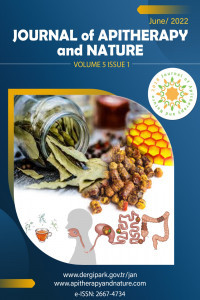Comparative Study of Commercial Propolis Based Products – Antibacterial Activity and Bioactive Compounds
Comparative Study of Commercial Propolis Based Products – Antibacterial Activity and Bioactive Compounds
Antibacterial Activity, Bioactive Compounds, Propolis,
___
- Bankova V (2005) Chemical diversity of propolis and the problem of standardization. Journal of Ethnopharmacology 100: 114-117
- Yayın Aralığı: Yılda 2 Sayı
- Başlangıç: 2018
- Yayıncı: Oktay YILDIZ
Portuguese Propolis: A Source of Valuable Bioactivities
A CUNHA, H ALVES, C ARAÚJO, L BARROSO, M CRUZ, As FREİTAS, Aj GOMES, R GONÇALVES, R MARQUES, B MOREİRA, C PASSÃO, M PEİXOTO, H PEREİRA, R SİLVA-CARVALHO, İ VALENÇA, Am FERREİRA, F BALTAZAR, F PİNTO-RİBEİRO, S CARDOSO, R OLİVEİRA, C ALMEİDA-AGUİAR
Muhammad IQBAL, Tai-ping FAN, David WATSON, Sameah ALENEZI, Muhamad SAHLAN
Ahmad SULAEMAN, M MAHANI, HARDINSYAH HARDINSYAH, E DARMA, S. R. MUBAROKAH, N NURJANAH
Portuguese Propolis: A Potenial Source of Environmentally Friendly Fungicides
Catarina PASSÃO, Claudia RODRIGUES, Cristina Almeida AGUIAR, Ana CUNHA
Propolis: A Natural Product – Great Potential as a Medicine
Flavonoids Constituents of Algeria Propolis
Segueni NARIMANE, Jesus. G. DIAZ, Akkal SALAH, Rhouati SALAH
İsamara Julia CAMURI, Adriano Batista COSTA, Wallance Moreira PAZIN, Amando Siuiti ITO
Determination of Propolis Origin Using Phenolic Composition and Artificial Neural Networks
İsabel REVILLA, Ana María VIVAR-QUINTANA, Pedro HERNÁNDEZ-RAMOS
The Efficacy of Propolis Fluoride in Inhibiting Dental Caries Activity on Primary Teeth
Risqa Rina DARWITA, Iwany AMALLIAH, Sri Angky SOEKANTO, Muhamad SAHLAN
An Exploration into the Relationship Between Propolis Production and Trypanosome Burden
